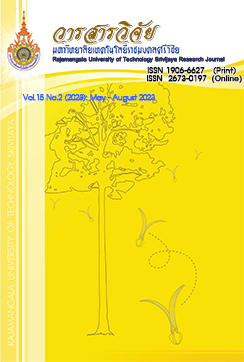Product Development of Reduced Sugar Lychee Gummy Jelly with Calcium Supplement
Keywords:
gummy jelly, Lychee, maltitol, calcium supplementAbstract
This research aimed to develop reduced sugar Lychee gummy jelly with calcium supplement. The effect of maltitol as sugar substitute on the quality of the product was studied. The result showed that maltitol content affected the color L, a, b of the products (p£0.05). However, it was not significantly different (p>0.05) in sensory quality. Final product was composed of 36.25% maltitol, 23.61% glucose syrup, 17.08% Lychee juice, 9.44% water, 8.61% gelatin, 2.78% calcium lactate, 1.24% citric acid, 0.96% pectin, and 0.03% potassium sorbate. The food colorant and artificial Lychee flavor were applied to improve the product appearance. According to the consumer test, 83.72% of the consumers accepted the product. The mean hedonic scores (7-point hedonic scale) of color, flavor, chewiness, springiness, sweet, sour and overall liking were 6.2±0.9 5.8±1.0 5.6±1.2 5.6±1.3 5.8±1.2 5.9±1.0 and 5.9±0.9, respectively. Reduced sugar Lychee gummy jelly with calcium supplement contained 20.08% moisture content, 10.14% protein, 0.01% lipid, 1.10% ash, 1.44% fiber, and 68.67% carbohydrate. The total sugar was 18.63 g/100g, which reduced from reference formula 39.08 g/100g. Calcium content was 527 mg/100g, which increased to 520.4 mg/100g from reference formula. Therefore, it could be claimed “reduced sugar” and “calcium supplement”. Microbial analysis of the product indicated that Total Plate Count and Yeast and Mold were less than 10 CFU/g. Staphylococcus aureus (in 1 g) was not detected and Escherichia coli was < 3 MPN/g.
References
AOAC. 2016. Official Methods of Analysis of AOAC International. 20thed. The Association of Official Analytical Chemists, MD, USA.
AOAC. 2019. Official Methods of Analysis of AOAC International. 21sted. The Association of Official Analytical Chemists, Washington DC, USA.
Depanya, W. 2008. Research Report on Development of Gummy Jelly Tamarind Product. Phetchabun Rajabhat University. (in Thai)
Garcia, T. 2000. Analysis of gelatin-based confections. The Manufacturing Confectioner 80(6): 93-101.
Medthai. 2017. Lychee: 27 properties and benefits of lychee. Available Source: https://medthai.com/%E0%B8%A5%E0%B8%B4%E0%B9%89%E0%B8%99%E0%B8%88%E0%B8%B5%E0%B9%88/, April 29, 2021. (in Thai)
Meesang, S., Wuttichamnong, P., Pongsawatmanit, R. and Chuenput, S. 2003. Effect of gelatin sucrose/glucose syrup ratio and citric acid on physical properties and sensory quality of gummy jelly product, pp. 20-27. In Proceedings of 41st Kasetsart University Annual Conference: Science and Genetic Engineering. Architecture and Engineering, Agro-Industry, Natural Resources and Environment, Bangkok. (in Thai)
Ministry of Public Health of Thailand. 1998. Nutrition Labelling, Issue 182, 1998. Available Source: http://food.fda.moph.go.th/law/data/announ_moph/P213.pdf, April 29, 2021. (in Thai)
Norsuwan, T. and Tantechai, S. 2018. Effect of maltitol on physical and chemical properties of low calorie passion fruit jam, pp. 863-870. In Proceedings of 56th Kasetsart University Annual Conference: Science and Genetic Engineering. Architecture and Engineering, Agro-Industry, Natural Resources and Environment, Bangkok. (in Thai)
Phetlomthong, P. and Rattanatraiwong, P. 2014. Sugar and sweetener: The current consumption trend. King Mongkut's Agricultural Journal 32(1): 77-86. (in Thai)
Praditduang, S. and Chaiseri, S. 1996. Confectionery and Chocolate. Kasetsart University, Bangkok. (in Thai)
Puechkaset. 2018. Lychees: Properties and Cultivation of Lychees. Available Sources: http://WWW.puechkaset.com/lychees, December 2, 2018. (in Thai)
Rajamanee, P, Sihabandit, U., Homelakorn, S., Lelaikham, B., Phichai, S. and Phoranso, W. 2017. Development of Ginger Gummy Jelly Product, pp. 629-633. In S. Teemueangsai, ed. RMU Graduate Research Conference (GRC2017). Rajabhat Maha Sarakham University, Maha Sarakham. (in Thai)
Rittilert, P and Warin, K. 2019. Development of Karanda (Carissa carandas L.) Gummy Jelly Product. Thai Journal of Science and Technology 9(2): 342-354. (in Thai)
Somthawill, S. and Sriwattana, S. 2012. The Use of Just About Right Scales in Reformulation of Thai Northern Style Sausage, pp. 167-174. In Proceedings of 50th Kasetsart University Annual Conference: Agro-Industry. Kasetsart University, Bangkok. (in Thai)
Sullivan, D.M. and Carpenter, D.E. 1993. Methods of Analysis for Nutrition Labeling. AOAC International, Arlington, USA.
Supimarot, S. 2000. Confectionery and Chocolate Technology. Chulalongkorn University Printing House, Bangkok. (in Thai)
Suwan, T., Pradutprom, W., Ngamroop, W., Choosuk, N. and Phungamngoen, C. 2017. Development of Babbler’s Bill Leaf Gummy Jelly. Burapha Science Journal 22(1): 189-201. (in Thai)
Thai Industrial Standards Institute (TISI). 2004. Thai Community Product Standard of Dried Jelly: TCPS.520/2003. Published documents, TISI, Bangkok. (in Thai)
Downloads
Published
How to Cite
Issue
Section
License
Copyright (c) 2023 Rajamangala University of Technology Srivijaya Research Journal

This work is licensed under a Creative Commons Attribution-NonCommercial-NoDerivatives 4.0 International License.
The content and information in the article published in Journal of Rajamangala University of Technology Srivijaya It is the opinion and responsibility of the author of the article. The editorial journals do not need to agree. Or share any responsibility.







